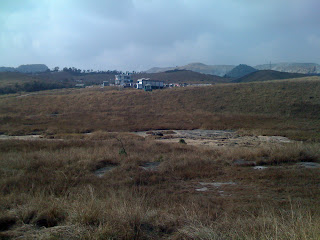On Tuesday December 22 I went sightseeing. I hired a van with a driver for the day and Zovi, her sister and her friend Sony and four of the teenage children of Rev. Pachuau joined me. We went to Cherrapunji, the place that receives the highest annual rainfall of any place on the planet at more than 11 meters / 450 inches per year and more; in one peak year there was 23 meters / 900 inches of rainfall. The title however is disputed with the nearby village of Mawsynram. We first stopped near Cherrapunji village at the Nohkalikai Falls, the fourth-highest waterfall in the world.
 The Nohkalikai Falls
The Nohkalikai Falls
Cherrapunji is just about the most bizarre place I have ever been. Even though it receives more rainfall than anywhere else, the area suffers from drought, with only dried-out low-lying scrub brush to be seen. Meghalaya as a whole consists of a high mountain plateau. Cherrapunji is on the edge of the high plateau, right where the plateau drops off at an exceptionally high sheer cliff, as the photograph of Nohkalikai Falls shows. During the summer months of the monsoon season, moisture-filled winds blow up from the Bay of Bengal across the wide, low-lying plains of Bangladesh but are then funneled into narrower valleys and then hit the cliffs. The winds are pushed up and rapidly cool to produce uniquely heavy torrential downpours in the immediate area. That makes perfect meteorological sense.
But why the area is so dry remains a mystery, since I have not been able to find anything on the internet that explains that satisfactorily. Deforestation is cited as a cause, but that does not make much sense, because it does not explain why there seem to be no lakes, ponds or water reservoirs in the area. It seems that the locals do not harvest much of the rainfall to use throughout the year. Instead they have to have water brought in by tanker truck for much of the year. It only rains during the monsoon months, and not much during the rest of the year (there was some fog, but no rain during my week in Shillong).
I do not know how much more forested the area was in the past, but today the only trees around are in sheltered low-lying areas or on the mountain slopes. In most areas the ground surface consists of bare bedrock with only the thinnest of soil covering.
But why the area is so dry remains a mystery, since I have not been able to find anything on the internet that explains that satisfactorily. Deforestation is cited as a cause, but that does not make much sense, because it does not explain why there seem to be no lakes, ponds or water reservoirs in the area. It seems that the locals do not harvest much of the rainfall to use throughout the year. Instead they have to have water brought in by tanker truck for much of the year. It only rains during the monsoon months, and not much during the rest of the year (there was some fog, but no rain during my week in Shillong).
I do not know how much more forested the area was in the past, but today the only trees around are in sheltered low-lying areas or on the mountain slopes. In most areas the ground surface consists of bare bedrock with only the thinnest of soil covering.
 The landscape around the Nohkalikai Falls
The landscape around the Nohkalikai Falls
We then went to the nearby Mawsmai natural cave, which extended for a couple hundred meters.

The group at the entrance to the Mawsmai Cave
 The group in the Mawsmai Cave
The group in the Mawsmai Cave
Along the way to the Mawsmai Cave I spotted a store identified as a cement dealership. In an episode of intercultural bewilderment, my friends just could not understand why I found it odd to note the other sign advertising pure honey for sale. They recognized of course that the store was in fact a general store that sells a variety of products, not just the combination of cement and honey that is advertised.

The cement dealership that also sells honey
We then went to the nearby Mawsmai Eco-Park, where I saw the first foreigner since leaving Delhi; throughout the week I only saw a handful of foreigners in Shillong. Here again the landscape is drier than even the bleak prairie of South Dakota, where my father grew up on a farm.

The Mawsmai Eco-Park
 The Mawsmai Eco-Park
The Mawsmai Eco-Park The Mawsmai Eco-Park with some ancient monoliths
The Mawsmai Eco-Park with some ancient monoliths
But one indication of the amount of rain that can fall during the monsoon season is the walk-way bridge over a water course that is now nearly dry.
 The Mawsmai Eco-Park Bridge
The Mawsmai Eco-Park Bridge The Elephant Falls
The Elephant Falls
We also stopped at a scenic outlook over the city of Shillong, but it was too misty and cloudy to see much of anything.
No comments:
Post a Comment